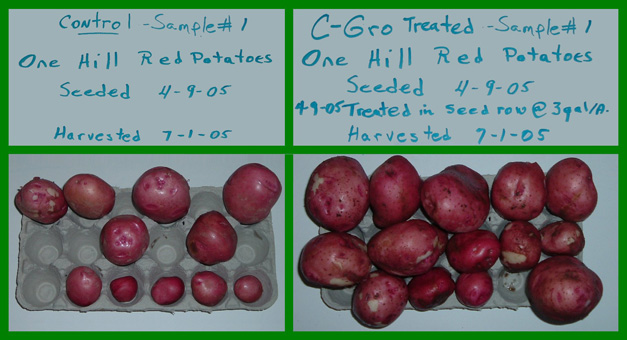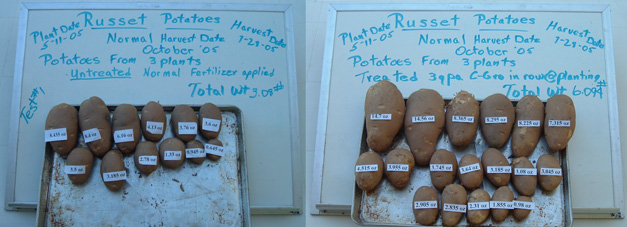SEA-CROP
concentrate is a mycorrhizal stimulant containing over 80 natural
source minerals and active organic substances from deep sea Pacific
Ocean water.
|
|
||
 |
||
|
C-Gro (SEA-CROP) treated
potatoes weighed 90% more than those without C-Gro (SEA-CROP).
Harvested at 73 days instead of 90 days as recommended. 2 1/2 weeks
earlier to market.Brix Refractometer readings 30% higher in treated
potatoes.
|
SEA-CROP
is a catalytic trigger that releases nature's energy to give the full
benefit of mycorrhizal symbiosis. The mycorrhizal fungi and beneficial
bacteria that are native and adapted to your soil are stimulated to
grow and reproduce abundantly, rapidly giving all of the well
documented benefits of mycorrhizal symbiosis.
What Are Mycorrhizae?
The word "mycorrhizae" literally means "fungus-roots" and defines the
close mutually beneficial relationship between specialized soil fungi
(mycorrhizal fungi) and plant roots. These specialized fungi colonize
plant roots and extend far into the soil resource. Mycorrhizal fungal
filaments in the soil are truly extensions of root systems and more
effective in nutrient and water absorption than the roots themselves.
Benefits include:
- Improved nutrient and water uptake
- Improved root growth
- Improved plant growth and yield
- Reduced transplant shock
- Reduced drought stress
- Parasitic nematode control
How do mycorrhizal fungi increase nutrient uptake?
These
fungi increase the surface absorbing area of roots 10 to 100x thereby
greatly improving the ability of the plants to utilize the soil
resource. Estimates of amounts of mycorrhizal filaments present in soil
associated with plants are astonishing. Several miles of fungal
filaments can be present in less than a thimbleful of soil! But
mycorrhizal fungi increase nutrient uptake not only by increaseing the
surface absorbing area of roots, they also release powerful chemicals
into the soil that dissolve hard to capture nutrients such as
phosphorous , iron and other "tightly bound" soil nutrients. This
extraction process is particularly important in plant nutrition and
explains why non-mycorrhizal plants require high levels of fertility to
maintain their health. Mycorrhizal fungi form an intricate web that
captures and assimilates nutrients, thus conserving the nutrient
capital in soils. In non mycorrhizal conditions much of this fertility
is wasted or lost from the system.
What other activities do mycorrhizal fungi do?
Mycorrhzial
fungi are involved with a wide variety of other activities that benefit
plant establishment and growth. The same extensive network of fungal
filaments important to nutrient uptake is also important in water
uptake and storage. In non-irrigated conditions, mycorrhizal plants are
under far less drought stress compared to non-mycorrhizal plants.
Mycorrhizal fungi also improve soil structure. Mycorrhizal filaments
produce humic compounds and organic "glues" (extracellular
polysaccharides) that bind soils into aggregates and improve soil
porosity. Soil porosity and soil structure positively influence the
growth of plants by promoting aeration, water movement into soil, root
growth, and distribution. In sandy or compacted soils the ability of
mycorrhizal fungi to promote soil structure may be more important than
the seeking out of nutrients. Over 90% of the world's plant species
require mycorrhizal association for maximum performance.

|
Untreated
|
Treated
|
SEA-CROP is more economical than other treatments that are less effective and reliable.
Mychorrizal inoculation is limited to only a few species and does not always work.
SEA-CROP stimulates the mycorrhixzal fungi and beneficial bacteria that are native and adapted to your soil causing them to grow and reproduce abundantly.
 |
|
Leaves and raspberries from ordinary raspberry plant on left and SEA-CROP plant on right. The 6 berries from the treated plant weighed 20.66 gm and the
6 berries from the control weighed 8.53 gm. |
Types of Mycorrhizal Plants:
Some commercially important plant groups that benefit from ENDO-mycorrhizae:
| Acacia | Brazilian Rubber | Crab Tree | Impatiens | Pacific Yew | Saltbrush |
| Agapanthus | Bulbs, all | Creosote Bush | Jojoba | Palms, all | Sequoia |
| Alder | Burning Bush | Cucumber | Juniper | Pampas Grass | Snapdragon |
| Almond | Cacao | Currant | Kiwi | Passion Fruit | Sourwood |
| Apple | Cactus | Cypress | Leek | Papaya | Soybean |
| Apricot | Camellia | Dodwood | Lettuce | Paw Paw | Spengeri Fern |
| Arauceria | Carrisa | Eggplant | Ligustrum | Peach | Squash |
| Artichoke | Carrot | Euonymus | Magnolia | Peanut | Strawberry |
| Ash | Cassara | Fern | Mahonia | Pecan | Sudan Grass |
| Asparagus | Ceanothus | Fescus | Maiden Grass | Pepper | Sugar Cane |
| Avocado | Cedar | Fig | Mango | Pistachio | Sumac |
| Bamboo | Celery | Forsythia | Maples, all | Pittosporum | Sunflower |
| Banana | Cherry | Fountain Grass | Marigold | Plum | Sweet Gum |
| Barley | Chinese Tallow | Fushia | Mesquile | Podocarpus | Sweet Potato |
| Bayberry | Chrysanthemum | Gardenia | Millet | Poinsetta | Sycamore |
| Bean | Citrus, all | Garlic | Mimosa | Potato | Taxus |
| Beech | Clover | Geranium | Mondo Grass | Rephiolepis | Tea |
| Begonia | Coconut | Grape (raisin) | Morning Glory | Raspberry | Tobacco |
| Black Cherry | Coffee | Grape (table) | Mountian Laurel | Redwood | Tomato |
| Blackberry | Coral Tree | Grape (wine) | Nasturium | Rice | Wheat |
| Black Locust | Corn | Green Ash | Okra | Rose | Yam |
| Blue Gramma | Cotton | Guayule | Olive | Russian Olive | Yucca |
| Box Elder | Cottonwood | Hibiscus | Olive Palm | Ryegrass | |
| Boxwood | Cowpea | Holly | Onion | Sagebrush |
Some commercially important plant groups that benefit from ECTO-mycorrhizae:
| Arctostaphylos | Douglas-fir | Fir | Larch | Pine | Spruce |
| Birch | Eucalyptus | Hemlock | Oak/Beech | Popular | Walnut |
Plant groups that do not respond to these types of mycorrhizae:
| Beet | Orchid | Protea |
| Carnation | Rush | Sedge |
| Heath | Rhododendron | Azalea |

|
C-Gro (SEA-CROP)
treated russet potatoes on the right compared to untreated russets on
the left. These potatoes are about two weeks away from scheduled
harvest time, but a couple of the treated potatoes are large enough to
qualify for harvest already. The total weight of the treated potatoes
is already nearly twice the weight of the untreated potatoes.
|
SEA-CROP Increases Soil Health
Wheat was germinated in soil tests and grown out for 20 days before analysis of the soil. The soil was then sent to an independent soils laboratory for quantitative testing of total bacterial biomass and total fungal biomass.
The control sample received no fertilizer or treatment with SEA-CROP. This sample was used to establish a baseline.
A second test sample received a complete fertilizer and no SEA-CROP.
The third sample received the complete fertilizer and treatment with SEA-CROP at the rate of one gallon per acre.
| Total Bacterial Biomass (ug/g) |
Total Fungal Biomass (ug/g) |
|
| Baseline | 872 | 547 |
| Fertilizer only |
1,183
|
692 |
| Fertilizer plus SEA-CROP | 1,282 | 1,075 |
SEA-CROP when used with fertilizer increased the total bacterial biomass by 47% over the baseline. Fertilizer alone only increased the total bacterial biomass by 36%.
SEA-CROP when used with fertilizer increased the total fungal biomass by 97% over the baseline. Fertilizer alone only increased the total fungal biomass by 27%.
These results are beyond significant and clearly demonstrate that certain measured parameters of soil health are greatly improved when soil is treated with SEA-CROP.

Over 90% of the world's plant species require mycorrhizal association for maximum performance.
©2006 Ambrosia Technology

